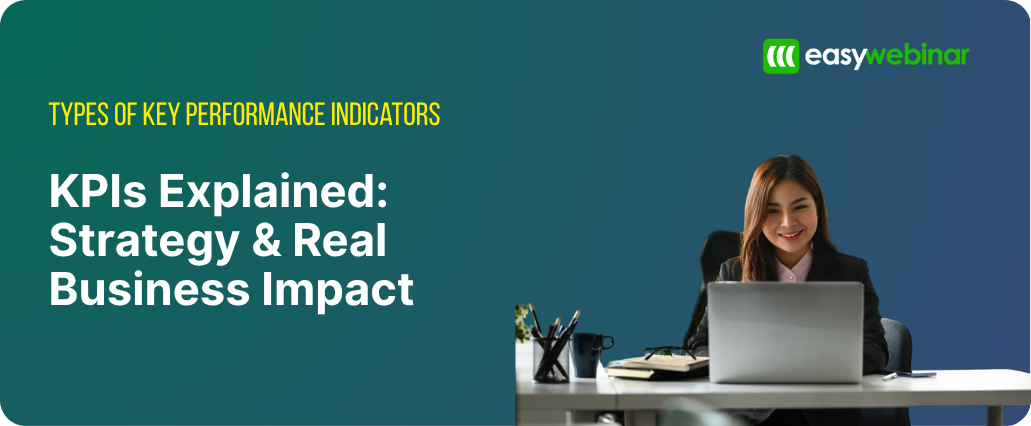What Is a KPI (Key Performance Indicator)? Strategy, Setup, and Real Business Impact

Summary :
Success with KPIs starts by focusing on what truly matters. Top-performing companies use only 5–7 well-chosen KPIs to track strategic goals effectively. This blog explains what KPIs are, why they’re essential, and how they help organizations measure progress, improve performance, and make smarter decisions.
KPIs are measurable metrics that evaluate business success across areas like finance, operations, customer service, and employee performance. The blog breaks down the types of KPIs strategic, operational, functional, leading, and lagging, and explains how they work together to guide both daily activities and long-term strategy.
You’ll also learn how to build a KPI system using the SMART framework (Specific, Measurable, Achievable, Relevant, Time-bound), assign clear ownership, maintain data quality, and adapt your metrics as business needs evolve. With regular reviews, KPI dashboards, and data-backed decision-making, companies can create a performance culture that drives consistent, measurable growth.
Ultimately, KPIs serve as a compass, turning abstract goals into concrete outcomes, aligning teams with strategy, and helping businesses confidently move toward their most important objectives.
Table of Contents
- What is a KPI and why it matters
- Types of KPIs and how they work
- How to set and measure KPIs effectively
- Conclusion
- FAQs
Success with KPIs starts with a simple truth: less is more. Top performing companies use only 5-7 KPIs to track their progress toward goals. Many organizations find it hard to pick the metrics that truly matter.
Key performance indicators (KPIs) measure a company’s long-term performance. These metrics paint a complete picture of your organization’s progress against targets and business goals.
The best leadership teams track no more than 25 measures that line up with balanced scorecard categories:
- Financial
- Customer
- Process
- People
Learning to develop, implement, and measure KPIs helps businesses change unclear goals into measurable targets that boost performance.
This piece breaks down what KPIs really are and why your business needs them. You’ll learn to build a practical measurement system that gets results. The content serves both newcomers to performance tracking and veterans who want to improve their approach.
What is a KPI and why it matters
Key Performance Indicators are the foundations of business measurement. A KPI is a measurable metric that shows success in reaching key business goals. These measurements help companies track their long-term performance against specific targets, objectives, or industry peers.
KPIs are quantitative values that show an organization’s critical success factors. They do more than just measure – they help us learn about what matters most to your business strategy. These indicators connect abstract business goals to real operations and give purpose to your plans while tracking progress systematically.
KPIs matter deeply throughout an organization. The right indicators communicate results clearly, which lets management make better strategic decisions. These measurements help spot bottlenecks and inefficiencies to streamline operations and boost overall performance.
Picture KPIs as your business GPS – they show exactly where you stand compared to your destination. Companies without KPIs often can’t tell if they’re heading the right way or need to change course. You simply can’t improve what you don’t measure.
KPIs come in various forms:
- Strategic KPIs monitor organizational goals like return on investment and market share
- Operational KPIs measure shorter-term performance and efficiencies
- Leading indicators predict future performance
- Lagging indicators reflect past performance
KPIs work best when they follow the SMART framework – Specific, Measurable, Achievable, Relevant, and Time-bound. This approach makes sure you measure what truly matters.
KPIs encourage accountability and transparency in organizations. People who understand and own their KPIs keep business goals as their priority. So every task becomes purposeful and moves the organization steadily toward its strategic objectives.
Types of KPIs and how they work
Organizations create balanced performance measurement systems by understanding KPI classifications. Businesses use unique combinations of key performance indicators that align with their goals.
- Strategic KPIs:
- Provide a big-picture view of organizational health.
- Track long-term objectives and influence executive decision-making.
- Common examples:
- Return on Investment (ROI)
- Revenue
- Market share
- Operational KPIs:
- Focus on short-term, day-to-day business processes.
- Measure organizational efficiency and process performance.
- Common examples:
- Sales by region
- Production output
- Inventory turnover
- Customer service resolution times
- Functional KPIs:
- Tailored to specific departments for targeted performance tracking.
- Examples by department:
- Finance: Gross profit margin
- IT: System uptime
- Marketing: Website traffic, lead generation
- Sales: Conversion rates, customer lifetime value
- Leading vs. Lagging Indicators:
- Leading KPIs:
- Predict future performance.
- Help spot potential issues early.
- Example: Customer satisfaction scores (can indicate future revenue trends)
- Lagging KPIs:
- Reflect past performance.
- Confirm the effectiveness of strategies.
- Examples: Revenue, profit margins, market share
- Leading KPIs:
- Balanced KPI Strategy:
- A successful KPI framework combines both leading and lagging indicators.
- Leading KPIs enable proactive management and early course correction.
- Lagging KPIs validate outcomes and long-term strategy.
- Analogy: Like driving, use both the windshield (leading) and rearview mirror (lagging) for safety and direction.

How to set and measure KPIs effectively
Building effective KPIs starts with a clear strategic foundation. Organizations must define their business objectives before picking indicators that track progress toward those goals. This arrangement will give every measurement a direct contribution to organizational success instead of creating data noise.
Use the SMART Framework to Set Effective KPIs
The SMART framework provides a proven structure for creating meaningful and actionable KPIs. It ensures that every KPI you define is aligned with business goals and can drive real impact. Each letter in SMART stands for a key attribute that makes a KPI effective:
- S — Specific:
A KPI should clearly define what is being measured and why it matters. Vague goals like “increase performance” don’t help. Instead, use a specific focus like “increase lead conversion rate” or “reduce customer churn.” Specificity gives teams direction and helps them stay aligned. - M — Measurable:
A KPI must be quantifiable so progress can be tracked objectively. You should be able to answer: How will I know if we’re making progress? For example, “increase customer satisfaction score from 78% to 85%” is measurable, whereas “make customers happier” is not. - A — Achievable:
KPIs should be realistic and attainable based on available resources and constraints. Overly ambitious goals can discourage teams, while achievable ones motivate progress. Ask yourself if the target is doable given the team’s current capabilities and market conditions. - R — Relevant:
The KPI must align with broader business objectives and be meaningful to the team tracking it. Relevant KPIs drive strategic decisions and help departments focus on what really moves the needle. For instance, a marketing team might track lead quality rather than just lead volume if the goal is better sales alignment. - T — Time-bound:
Every KPI needs a clear timeline to create urgency and accountability. Open-ended goals like “increase traffic” lack momentum. Instead, use time-boxed KPIs like “increase website traffic by 20% in the next quarter” to keep teams focused and results-oriented.
How Many KPIs Should You Track?
Successful organizations typically focus on 1–5 SMART KPIs per department, ensuring each one connects directly to a specific team goal. Executive teams often monitor fewer than 25 KPIs total, distributed across key business areas such as Finance, Customer, Internal Process, and Learning & Growth, as defined by the Balanced Scorecard methodology.
By applying the SMART framework and focusing on a manageable number of indicators, you ensure that every KPI is actionable, aligned, and measurable, leading to better strategic outcomes and more focused execution.
KPI effectiveness depends on clear ownership. Each indicator needs three specific owners: someone to define the KPI, implement its measurement, and use results to boost performance. Setting realistic targets gives teams clear standards. Teams know how much improvement they expect, deadlines, and who takes responsibility.
Quality data supports reliable KPIs. Organizations should review data availability, run validation checks, and use data governance practices to maintain accuracy. Multiple data sources working together give a complete view that removes blind spots.
Teams should meet monthly or quarterly to discuss progress, tackle challenges, and adjust course. Dashboard visualization creates transparency and makes performance visible to stakeholders whatever their location.
KPIs must grow with your business. Review your indicators often to keep them relevant as strategies move and business environments change. Yes, it is true that top organizations see KPIs as dynamic tools for continuous improvement rather than fixed metrics.
Note that tracking KPIs without action wastes effort. These measurements should drive decisions and performance improvements that push your strategic objectives forward.
Conclusion
KPIs act as a compass in your business experience and turn abstract goals into measurable wins. This piece shows how strategic, operational, and functional KPIs combine to paint a detailed picture of performance. Without doubt, successful companies put quality before quantity. They focus on 5-7 key indicators instead of getting lost in too many metrics.
A KPI system works best with clear ownership and regular monitoring. Taking action based on what you learn matters most. Even the best measurement systems become useless exercises without these basics. Your KPIs should adapt as your business strategy shifts to stay relevant when market conditions change.
The SMART framework gives you a hands-on way to build meaningful indicators that propel real progress. It also helps to balance leading and lagging indicators. This approach works like using both your windshield and rearview mirror while driving.
KPIs link every part of your business to its strategic goals. Team members who see their individual impact through clear metrics naturally become more accountable. Your organization then moves with purpose toward shared goals instead of working in isolated silos.
Begin with a focused set of indicators that truly impact your business results. You’ll soon find how the right KPIs turn vague hopes into concrete outcomes. This clarity helps you make confident decisions that lead to eco-friendly growth.
FAQs
Q1. What exactly is a KPI and why is it important for businesses?
A KPI (Key Performance Indicator) is a quantifiable metric used to evaluate an organization’s success in achieving specific objectives. It’s crucial for businesses as it provides a measurable way to track progress, identify areas for improvement, and make data-driven decisions to achieve strategic goals.
Q2. How many KPIs should a company typically focus on?
Most effective organizations focus on a limited number of KPIs, typically between 5-7 key indicators. This approach allows for a more focused and manageable performance tracking system, avoiding information overload and ensuring attention is directed to the most critical aspects of the business.
Q3. What’s the difference between leading and lagging KPIs?
Leading KPIs are predictive measures that can indicate future performance, such as customer satisfaction scores. Lagging KPIs, on the other hand, measure past performance, like revenue or profit margins. Using both types provides a comprehensive view of business performance and enables proactive management.
Q4. How often should KPIs be reviewed and updated?
KPIs should be monitored regularly, with many organizations conducting monthly or quarterly check-ins. However, it’s important to periodically review and update your KPIs to ensure they remain relevant as your business strategy evolves and market conditions change.
Q5. What makes a KPI effective?
An effective KPI follows the SMART framework: Specific, Measurable, Achievable, Relevant, and Time-bound. It should be directly aligned with business objectives, have clear ownership, be based on reliable data, and most importantly, drive action and decision-making to improve performance.
